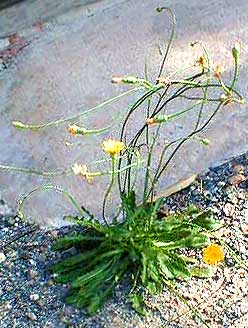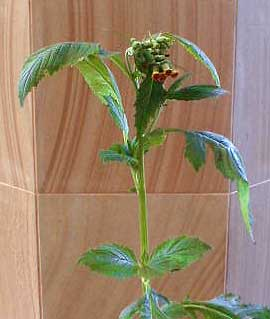All text and images from http://middlepath.com.au/plant/weeds.php with thanks.
|
|
The Catsear plant looks very similar to Dandelion, but has several branches coming from the central stalk with a smaller yellow flower and leaves. Dandelion flower stalks are hollow bearing a single flower and this provides a reliable differentiation between the two plants. The leaves are edible and can be used as a vegetable in stir frys and steamed or boiled. The root may also be used to make coffee by roasting. In Europe this “weed” is still a delicacy – served with olive oil and garlic – used in the same manner as Dandelion. Catsear’s medicinal properties are similar to Dandelion but less potent. I have found it of great benefit for a variety of Liver conditions. At present my investigations into this plant’s medicinal and nutritional properties are incomplete, but I regard it as a useful alternative to Dandelion. |
|
|
This lovely low-growing, trailing weed is delicious; the whole herb is used in salads, soups or stir fry’s and as a herbal tea. Chickweed is very high in Protein and minerals. It is very high in Vitamin C and is excellent for helping to dissolve fats in the body. Helps to liquefy and remove mucous from the Respiratory tract. Is used to stop bleeding and inflammation from the lungs, bowels and stomach. Used as a poultice it is wonderful for rashes and sores and a great scrub for acne. Is excellent for weight reduction, particularly in discouraging fat retention. |
|
Of all the wild food available in Australia the Cobblers Peg, otherwise called Farmers Friend because the seed sticks to you, would have to be the most unpopular. And yet, in many other parts of the world – mainly the Southern hemisphere interestingly enough, it is a popular and widely-used foodstuff and medicine. Its therapeutic uses are extraordinarily comprehensive (as the list below demonstrates), where it is in daily use as a vegetable. The leaves are dried and stored for future use. |
As a foodstuff, it is in daily use as a vegetable in Africa. The leaves can be dried and stored for future or cooked. Some folks advise draining and refreshing the water often during cooking to purge the bitterness from the taste. We use the leaves straight from the plant in salads or direct to the mouth and experience no bitterness. The taste is a slightly nutty flavour and, like all herbs, our bodies will tell us exactly and unambiguously when we have eaten enough in one session. We had a drive full of Cobblers Pegs when we first arrived here at Middle Path, but found that when we applied a few applications of rock powder to the area where they where growing, they didn’t come back. Nature has an amazing way of restoring the balance. Wherever our neighbours spray chemicals there come up the Cobblers Pegs like a lawn doing their utmost to restore balance again. A friend of mine sent for some seeds of a particular herb overseas which was known to be excellent for stomach ulcers. When she got the seeds, she laughed, it was Cobblers Pegs. This weed is rich in minerals and especially Calcium which is the great healer for stomach ulcers. Cobblers Pegs can be dried and used as a herbal tea as well as a vegetable source. |
|
|
The young stalks, leaves, roots and flowers can be eaten. It is well known medicinally for its beneficial effect on the Liver and help in the production of breast milk. The seeds were a specific to be taken when you had stitches in your side, and are used for cardiovascular disorders. However these are very powerful and should not be taken without the guidance of an experienced herbal practitioner. Milk thistle helps nausea and travel sickness as well. I have known it to be used topically for leg ulcers and varicose veins. It is a great tonic and increases appetite and aids in digestion. At Middle Path, we use it as a tea or in our salad or stir fry. |
|
|
Sometimes regarded as a newcomer amongst Australian weeds, thickhead was largely unknown to the non-indigenes of Australia only 20 years ago. The plant is thought to have its origins in Africa. At Middle Path we use it in our salads and it has a flavorsome nutty taste. It grows here and there amongst rockeries, hills and gardens. It is a wonderful new addition to our salad greens. I understand it has been in widespread use amongst the Australian Aborigines as a salad green – either cooked or eaten raw. At present my investigations into this plant’s medicinal and nutritional properties are incomplete. |





